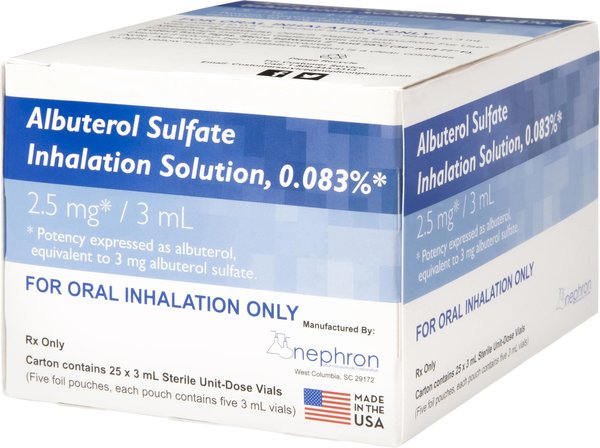Albuterol
Published .

Albuterol is used for the treatment and prevention of bronchospasm (acute or severe) in patients with reversible obstructive airway disease. It also has an indication for the prevention of exercise-induced bronchospasm.
Indications
Albuterol, also known as salbutamol, has an indication for the treatment and prevention of bronchospasm (acute or severe) in patients with reversible obstructive airway disease, including exercise-induced bronchospasm. Without the bronchodilatory effects of albuterol, the individual may suffer catastrophic asphyxiation, making this drug highly desirable to keep on hand for individuals who suffer from recurring obstructive airway symptoms such as asthma.
Mechanism of Action
Albuterol acts on beta-2 adrenergic receptors to relax the bronchial smooth muscle. It also inhibits the release of immediate hypersensitivity mediators from cells, especially mast cells. Although albuterol also affects beta-1 adrenergic receptors, this is minimal and has little effect on the heart rate.
Administration

Albuterol comes in a variety of dosing forms and strengths. An aerosol metered-dose inhaler gives 90 mcg (base)/actuation, which is equivalent to 108 mcg of albuterol sulfate. The powder metered-dose inhaler form gives the same values as the aerosol metered-dose inhaler.
Several forms of albuterol are accepted for the treatment of bronchospasm. A nebulized solution of 2.5 mg two or three times a day as needed is acceptable for quick relief of symptoms. Dosing of 1.25 to 5 mg every four to eight hours as needed of the nebulized solution is also effective for quick relief of symptoms. For the powdered and aerosol metered-dose inhaler, the advice is to use one or two puffs of 90 mcg every four to six hours depending on the patient, but it is advised not to exceed 12 puffs within 24 hours.
For the treatment of acute or severe bronchospasm, it is advisable to use a nebulizer solution with a concentration of 2.5 to 5 mg every 20 minutes for three cycles, followed by repeat nebulizer treatments of 2.5 to 10 mg every 1 to 4 hours as needed. Treatment can be maintained with continuous nebulizer treatments every 10 to 15 minutes.
For the treatment of pediatric patients, age becomes a significant factor in the course of treatment. For children under two years old, nebulizer solution with dosing by weight of 0.2-0.6 mg/kg/day divided into either a 4- or 6-hour cycle. For children two years old and older, a nebulizer solution dosing of the 2.5 mg/0.5 mL solution is given every 6 to 8 hours with a maximum of 10 mg given in any 24 hours.
The use of aerosol metered-dose inhalers in the pediatric population under the age of 4 years old has not had research conducted. The dosing recommendation for four years and older is 90 to 180 mcg (1 to 2 puffs) every 4 to 6 hours.
The use of powder metered-dose inhalers in the pediatric population under the age of 4 years old has not been studied. Dosing recommendation for four years and older to take 180 mcg (2 puffs) every 4 to 6 hours not to exceed 12 puffs within 24 hours.
Adverse Effects
The primary adverse effects of albuterol therapy are tremors and nervousness, mostly seen in children who are 2 to 6 years of age, though can be seen at any age. Tremors are the result of activation of the beta-2 receptors found on the motor nerve terminals. These side effects occur in approximately one in every five patients. Other side effects include insomnia and nausea, which occur in approximately 1 in every ten patients. Less common adverse effects may include fever, bronchospasm, vomiting, headache, dizziness, cough, allergic reactions, otitis media, epistaxis, increased appetite, urinary tract infections, dry mouth, gas, hyperhidrosis, pain, dyspepsia, hyperactivity, chills, lymphadenopathy, ocular pruritus, sweating, conjunctivitis, and dysphonia. Albuterol also has been shown to increase blood pressure and may cause hypokalemia.
Contraindications
Hypersensitivity is a contraindication for albuterol. Also, if a patient is severely hypersensitive to milk protein, it is advised to avoid the use of albuterol.
Monitoring
Monitoring parameters for albuterol include forced expiratory volume, peak flow, blood pressure, and heart rate. Since paradoxical bronchospasm may occur, it is important to advise patients to discontinue use and seek medical attention if symptomology worsens with use. If more doses are necessary over time, the clinician may need to make alterations to the patient’s current treatment regimen, as the patient’s condition may have deteriorated.
Toxicity
A dose of 1 mg/kg is potentially toxic in the pediatric population under the age of six. Similar to other beta-2 adrenergic receptor agonists, albuterol has been shown to cause an increase in liver aminotransferase concentrations on very rare occasions. This particular toxicity reaction is much more common in other beta-2 adrenergic receptor agonists, such as terbutaline, that are administered in much greater quantities such as in the case of abating uterine contractions.
